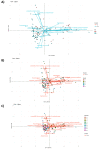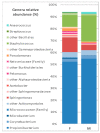Influence of Sex on the Microbiota of the Human Face
- PMID: 36557723
- PMCID: PMC9786802
- DOI: 10.3390/microorganisms10122470
Influence of Sex on the Microbiota of the Human Face
Abstract
The role of the microbiota in health and disease has long been recognized and, so far, the cutaneous microbiota in humans has been widely investigated. The research regarded mainly the microbiota variations between body districts and disease skin states (i.e., atopic dermatitis, psoriasis, acne). In fact, relatively little information is available about the composition of the healthy skin microbiota. The cosmetic industry is especially interested in developing products that maintain and/or improve a healthy skin microbiota. Therefore, in the present work, the authors chose to investigate in detail the structure and composition of the basal bacterial community of the face. Ninety-six cheek samples (48 women and 48 men) were collected in the same season and the same location in central northern Italy. Bacterial DNA was extracted, the 16S rDNA gene was amplified by PCR, the obtained amplicons were subjected to next generation sequencing. The principal members of the community were identified at the genus level, and statistical analyses showed significant variations between the two sexes. This study identified abundant members of the facial skin microbiota that were rarely reported before in the literature and demonstrated the differences between male and female microbiota in terms of both community structure and composition.
Keywords: 16S rDNA; cutaneous microbiome; gene sequencing; human face.
Conflict of interest statement
The authors declare no conflict of interest.
Figures







References
-
- Iebba V., Totino V., Gagliardi A., Santangelo F., Cacciotti F., Trancassini M., Mancini C., Cicerone C., Corazziari E., Pantanella F., et al. Eubiosis and dysbiosis: The two sides of the microbiota. New Microbiol. 2016;39:1–12. - PubMed
LinkOut - more resources
Full Text Sources

